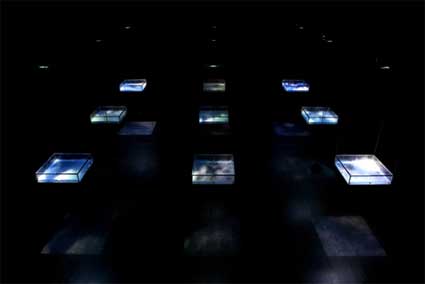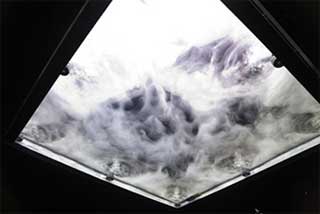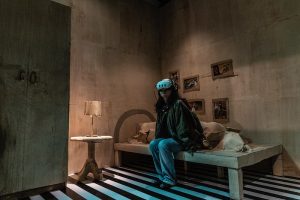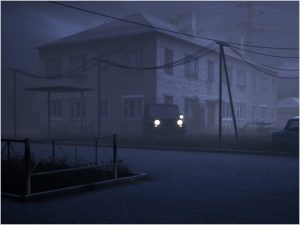A new story by Vicente Gutierrez, wmmna’s correspondent in Tokyo.
“I wanted to distance myself from the curse of time.” – Ryuichi Sakamoto
“I wanted the imagery to project completely free of control.” – Shiro Takatani
[quotes taken from ICC website]

The recent collaboration between composer Ryuichi Sakamoto (a founder of Yellow Magic Orchestra) and cinematographer Shiro Takatani (a founder of the dumbtype art collective) is their effort to escape the constraints of space and time, namely notions of sequence.
For Sakamoto, it´s composing without sticking to traditional time signatures or a single genre in a composition. For Takatani, it is allowing a computer-controlled system to select clips from the diverse body of video he produced for this installation. For both, avoiding linear forms of their respective fields is what they had worked towards by looking to generative art as an escape.
 LIFE: fluid, invisible,inaudible… started as an opera by Ryuichi Sakamoto in 1999 as his effort at presenting an overview of music and society in the 20th century; for that work, Takatani was brought in to help out with the visuals. From then, the two later collaborated with a short series of experimental live shows, the first being Garden Series Vol.1: Experimental Live at Honen-in Zen Temple in Kyoto where they used laptops to conduct the music and images. Fast forward to 2007 and ‘LIFE’ was commissioned as a work by the Yamaguchi Center for Arts and Media (YCAM) and later exhibited from March 10 to May 28 2007 at YCAM. Now, the newest, slightly evolved version of ‘LIFE’ is on display at the ICC center in Tokyo.
LIFE: fluid, invisible,inaudible… started as an opera by Ryuichi Sakamoto in 1999 as his effort at presenting an overview of music and society in the 20th century; for that work, Takatani was brought in to help out with the visuals. From then, the two later collaborated with a short series of experimental live shows, the first being Garden Series Vol.1: Experimental Live at Honen-in Zen Temple in Kyoto where they used laptops to conduct the music and images. Fast forward to 2007 and ‘LIFE’ was commissioned as a work by the Yamaguchi Center for Arts and Media (YCAM) and later exhibited from March 10 to May 28 2007 at YCAM. Now, the newest, slightly evolved version of ‘LIFE’ is on display at the ICC center in Tokyo.
‘Life:’ is a journey into the world Sakamoto and Takatani have created from a body of audio and visual work, and as the name suggests, it aims to be fluid, invisible and inaudible. Juxtaposing abstract sounds and distorted visuals with clearer, more sensible sounds and images throughout, two duo virtuously present the unknown, invisible and inaudible as perceptible to us.
The sounds and visions in ‘LIFE’ are stored on the hard disk of a central computer which is being controlled by an algorithmic program so the images are randomly withdrawn from the cache to create an installation which is generative and constantly changing. Although it was largely generative, it seemed that throughout the audio-visual collage there were moments where Sakmoto and Takatani cleverly synchronized their music and film for more dramatic effect.
But first, here’s how it works:
 The decentralized flow of sound and video is established by a 3 x 3 grid of aquarium-like tanks made from acrylic, which are each 30 cm high and 1.2 sqm. The acrylic aquariums, each accompanied by two adjacently hanging speakers on the ends, are hung in the pitch-black darkness of a large installation room. Each of the 9 cubes contains a thin film of water, about a few centimeters deep and inside, within which varying levels of fog and [subsequent] ripples are generated by the ultrasonic waves from (8) silent pumps planted in the corners. A couple meters above are the discreet ceiling-based projectors which channel the images downward into the water, acting as a screen.
The decentralized flow of sound and video is established by a 3 x 3 grid of aquarium-like tanks made from acrylic, which are each 30 cm high and 1.2 sqm. The acrylic aquariums, each accompanied by two adjacently hanging speakers on the ends, are hung in the pitch-black darkness of a large installation room. Each of the 9 cubes contains a thin film of water, about a few centimeters deep and inside, within which varying levels of fog and [subsequent] ripples are generated by the ultrasonic waves from (8) silent pumps planted in the corners. A couple meters above are the discreet ceiling-based projectors which channel the images downward into the water, acting as a screen.
Upon entering the room to the tune of layers of blissfully jarring sounds by Sakamoto, the set up is confronting- a room consumed by darkness with the nine hanging cubes, suspended about 3 meters above the floor; all together creating a grid-like set up where laying down accommodates the best view of a single cube; those who felt free slowly paced within and around the perimeter.







